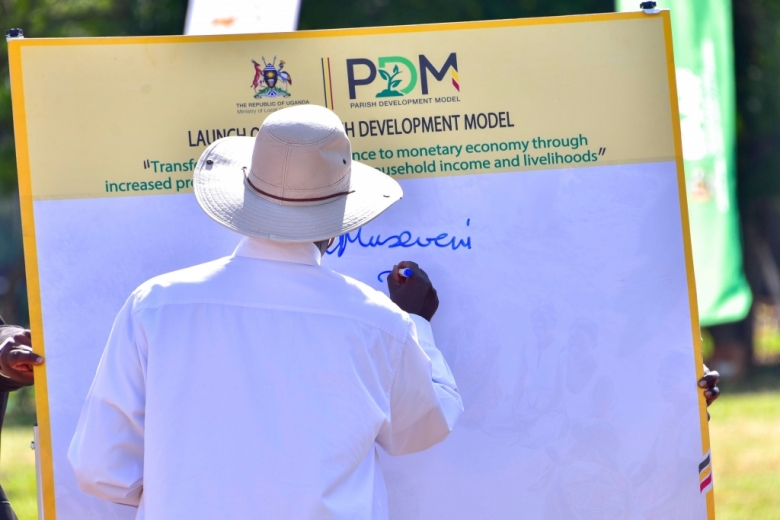UBOS REPORT: Only 2 in Every 10 Poverty-Stricken Ugandans Targeted to Benefit From PDM Trillions Are Being Impacted by The Programme
In a bid to reduce on the number of people and households still being trapped under subsistence way of life, President Museveni did promise mitigation during the campaigns for 2021. He rightly stated that it was unacceptable to have 3.5m households being totally excluded from the money economy largely because they don’t produce anything for […] The post UBOS REPORT: Only 2 in Every 10 Poverty-Stricken Ugandans Targeted to Benefit From PDM Trillions Are Being Impacted by The Programme appeared first on Watchdog Uganda.

In a bid to reduce on the number of people and households still being trapped under subsistence way of life, President Museveni did promise mitigation during the campaigns for 2021.
He rightly stated that it was unacceptable to have 3.5m households being totally excluded from the money economy largely because they don’t produce anything for sale and also don’t have money to spend to buy or acquire what they require for their basic day to day survival needs.
The 3.5m is just households and not actual number of people inhabiting them. And gratefully, the newly released final census report by UBOS has established that Uganda currently has a total of 10.7m households of which 7.2m or 67% are in money economy with something to sell besides having capacity to part with money to purchase and get what they need.
The census report, based on data thousands of UBOS enumerators collected across the country during the month of May 2024, shows that of the 10.7m households we currently have in Uganda, 33% or 3.5m still live under subsistence.
The UBOS report authors define subsistence to imply households which are financially so hard-up to the extent that their inhabitants are unable to adequately satisfy their basic needs specifically those relating to the purchase of food and non-food items. It’s this category of Ugandans, financially excluded and very vulnerable, that President Museveni sought to emancipate through the introduction of Parish Development Model.
According to Secretary to Treasury (PSST) Ramathan Goobi, as of last November, Shs2.06trn had been given out to cover such vulnerable groups under the PDM arrangement. The money was meant to cover such vulnerable groups in at least 10,589 perishes.
On Friday 22nd November, Goobi disclosed on his X handle that in the targeted parishes and districts, the Shs2.06trn was supposed to be distributed to cover up to 80-100% of intended beneficiaries.
However, during his ongoing PDM mobilisation and inspection tours across the country, the President has established that the very crippling problem of extortion and stealing of PDM funds is widespread and has vowed to crack the whip on culprits real hard.
According to the President, the PDM cash is meant to capacitate people living in the 3.5m targeted households to begin earning some money through undertaking appropriate activities and break away from the subsistence way of life which has seen then depend on nature-enabled activities such as hunting, gathering and rudimentary agriculture in order to make ends meet and afford basic survival.
The findings contained in the latest final census report by UBOS vindicate what the President has been saying namely that a lot of the intended beneficiaries have largely remained unimpacted because of extortion schemes by officials in the relevant local government structures across the country.
The UBOS-hired census enumerators went asking questions during the enumeration exercise while asking people if they had benefited at all from the PDM trillions. The report shows that of the 3.5m households the President rightly targeted, only inhabitants of 832,746 (basically 24%) admitted to ever benefiting from or getting impacted by the PDM intervention at all.
The 3.5m households targeted are the ones in subsistence and badly need emancipation to have higher incomes and lead a better quality life. Remarkably, the census final report establishes that Sebei sub region has registered the highest impact for PDM with 76% of the targeted households being impacted already.
Yet Busoga sub region is the least impacted with just 14.3% of the intended households benefiting. The report doesn’t render any explanation as to why Sebei has done so well and Busoga so poorly.
When it comes to gender, the UBOS report shows that males are benefiting much more than females from the PDM intervention. Of the 832,746 households that had so far been impacted as of May 2024, a total of 628,561 were male-headed households and a mere 204,185 female-headed.
The UBOS census report also unearthes equally very intriguing findings regarding the impact of other government interventions aimed at improving household incomes and welfare such as OWC, YLP, Emyoga, UWEP for women, SAGE for citizens aged 80 or more, Special Enterprise Grant for Older Persons (aged 60-79) and NAADs which has since been disbanded under the ongoing rationalization of government agencies. This aspect of the report will be detailed in our subsequent coverage of the census final report.
The post UBOS REPORT: Only 2 in Every 10 Poverty-Stricken Ugandans Targeted to Benefit From PDM Trillions Are Being Impacted by The Programme appeared first on Watchdog Uganda.



